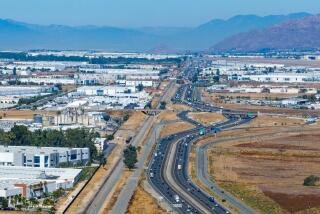Commentary : ‘Clustering’ Is the Key to Convenient Living 20 Years Down the Road
- Share via
Stepping out of his town home, he notices the mallard ducks on Lake Santa Margarita. Once a less common sight, wild fowl are now showing up at the lake in greater numbers because of the significant reduction in air pollution over the past 10 years.
He eases himself into his light alloy photovoltaic, battery-operated street cruiser and makes his way to the Foothill Transportation Corridor. As he passes a toll booth, his trip is automatically recorded from a sensor on the left fender of his vehicle. He is billed for his trips at the end of each month.
Once on the freeway, he begins reading a financial journal, paying little attention to the road. His route is programmed and, utilizing electromagnetic sensors on the road, his vehicle will whisk him to his office at the Irvine Spectrum Commercial Complex in just 4 minutes. A bond salesman, he takes a high-speed elevator to his 15th-floor office.
Later, meeting clients for lunch, he walks (others take the people mover) across a bridge connecting Towers I and III of the office complex. Tower III is devoted to retail, with nine restaurants, 11 stores, cleaning and other service shops, a fitness center and entertainment outlets.
Back at the office in the afternoon he will hold a teleconference linking offices in Tokyo, London, New York and Rio de Janeiro. At 6 p.m. he completes a 45-minute workout at the Tower I gymnasium, using computer-programmed exercise machines. His day ends with a client meeting over cocktails.
Typically, his weekdays are carried out within 8 miles of his home. When he does need to make a trip to San Diego, Newport Beach or Los Angeles, he uses a larger, more comfortable freeway cruiser designed for higher speeds and longer trips. It, too, has photovoltaic capabilities.
This is not a page from a science-fiction novel. Rather, it is a chapter of science future, a glimpse of what I think Orange County life will resemble in the year 2009. And the changes that will occur tomorrow will be the result of trends that are occurring today. Commercial real estate development is responsible for such trends and will be instrumental in making our lives more comfortable, efficient and economical.
Our bond seller’s average day represents what I believe will be an average day for most Orange County business people in the next century. His ability to live and work in close proximity, to travel quickly and conveniently in electric vehicles and to utilize sky bridges and people movers will be the result of the intelligent and advanced commercial planning and development that is now occurring in Orange County.
At the forefront of futuristic development is a concept called “clustering.” Designed to allow individuals to work, play and live in their immediate environment, clustering is the development of planned business parks and mixed-use facilities to reduce commuting time and freeway congestion.
With clustering, high-rise offices and homes will predominate the landscape, with work and entertainment complexes located within walking or short commute distances to planned living communities. The toll freeways will be used sparingly for long trips, while transportation corridors will be used for programmed routes for quick and efficient transportation.
Clustering is actually a corporate extension of a domestic trend known as “cocooning,” which has seen families spending more of their free time at home or in their immediate environment. This social trend increases the importance of amenities and entertainment close to home, and has spawned the emergence of planned communities and mixed-use developments.
Planned communities in Orange County such as Woodbridge, Westpark, Santa Margarita, Tustin Ranch and Mission Viejo have focused on this concept and emphasized homes, shopping and entertainment in the development and marketing of their communities.
On the commercial side, clustering is evidenced in developments such as North Irvine, The Spectrum, Pacific Park and Santa Margarita Business Park, and will be central to the proposed Horno and Foothill Ranch projects. For maximum clustering, these projects are near the planned residential communities I mentioned.
A desirable work and living environment is highly sought by major companies today and is one of the main reasons corporations such as Western Digital and AT&T; have moved to the Irvine Spectrum. With such corporate support, the concept of building work centers near the work force will continue to gain acceptance and result in additional clustered development.
The positive benefits of clustering, both to residents and the environment, ensure that it is a significant and far-reaching trend. Today’s clustered commercial development is shaping the Orange County of tomorrow and leading us toward the next century. It will have a direct and beneficial effect on our life styles and help determine the course of our “average” day in the year 2009.
More to Read
Inside the business of entertainment
The Wide Shot brings you news, analysis and insights on everything from streaming wars to production — and what it all means for the future.
You may occasionally receive promotional content from the Los Angeles Times.









